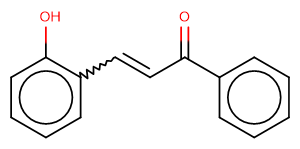
2-Hydroxychalcone
CAS No. 644-78-0
2-Hydroxychalcone( 2-(2-Hydroxybenzal)Acetophenone )
Catalog No. M21306 CAS No. 644-78-0
2-Hydroxychalcone can be used as antiparasitic hit compounds when Methoxylated.It can inhibit invasion of triple negative breast cancer cells.
Purity : >98% (HPLC)
 COA
COA
 Datasheet
Datasheet
 HNMR
HNMR
 HPLC
HPLC
 MSDS
MSDS
 Handing Instructions
Handing Instructions
| Size | Price / USD | Stock | Quantity |
| 100MG | 45 | Get Quote |


|
| 200MG | Get Quote | Get Quote |


|
| 500MG | Get Quote | Get Quote |


|
| 1G | Get Quote | Get Quote |


|
Biological Information
-
Product Name2-Hydroxychalcone
-
NoteResearch use only, not for human use.
-
Brief Description2-Hydroxychalcone can be used as antiparasitic hit compounds when Methoxylated.It can inhibit invasion of triple negative breast cancer cells.
-
Description2-Hydroxychalcone can be used as antiparasitic hit compounds when Methoxylated.It can inhibit invasion of triple negative breast cancer cells.
-
In Vitro2-Hydroxychalcone inhibits invasion of triple negative breast cancer cells.2-hydroxychalcone inhibits the adhesion of peripheral neutrophils to the endothelial cell monolayers by inhibiting the expression of ICAM-1, VCAM-1, and E-selectin in a concentration-dependent manner.
-
In Vivo——
-
Synonyms2-(2-Hydroxybenzal)Acetophenone
-
PathwayOthers
-
TargetOther Targets
-
RecptorOthers
-
Research Area——
-
Indication——
Chemical Information
-
CAS Number644-78-0
-
Formula Weight224.25
-
Molecular FormulaC15H12O2
-
Purity>98% (HPLC)
-
SolubilityIn Vitro:?DMSO : 125 mg/mL (557.41 mM)
-
SMILESOc1c(C=CC(c2ccccc2)=O)cccc1
-
Chemical Name2-Hydroxychalcone
Shipping & Storage Information
-
Storage(-20℃)
-
ShippingWith Ice Pack
-
Stability≥ 2 years
Reference
1.Kim S Y Lee I S Moon A . 2-Hydroxychalcone and xanthohumol inhibit invasion of triple negative breast cancer cells[J]. Chemico Biological Interactions 2013 203(3):565-572.
molnova catalog



related products
-
Src Inhibitor 3
Src Inhibitor 3 is an effective inhibitor of c-terminal Src kinase (IC50 <3 nM in CSK HTRF, <4 nM in Caliper assay). Src Inhibitor 3 increases T cell proliferation induced by T cell receptor signaling.
-
Syringic acid
Extracted from Kalimeris indica(L·) Sch-Bip;Store the product in sealed, cool and dry condition.
-
Diphenyl oxide
Used in the manufacture of spices and dyes.



 Cart
Cart
 sales@molnova.com
sales@molnova.com


